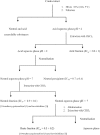Aspidosperma (Apocynaceae) plant cytotoxicity and activity towards malaria parasites. Part II: experimental studies withAspidosperma ramiflorum in vivo and in vitro
- PMID: 26560981
- PMCID: PMC4660620
- DOI: 10.1590/0074-02760150188
Aspidosperma (Apocynaceae) plant cytotoxicity and activity towards malaria parasites. Part II: experimental studies withAspidosperma ramiflorum in vivo and in vitro
Abstract
Several species of Aspidosperma plants are used to treat diseases in the tropics, including Aspidosperma ramiflorum, which acts against leishmaniasis, an activity that is experimentally confirmed. The species, known as guatambu-yellow, yellow peroba, coffee-peroba and matiambu, grows in the Atlantic Forest of Brazil in the South to the Southeast regions. Through a guided biofractionation of A. ramiflorum extracts, the plant activity against Plasmodium falciparum was evaluated in vitro for toxicity towards human hepatoma G2 cells, normal monkey kidney cells and nonimmortalised human monocytes isolated from peripheral blood. Six of the seven extracts tested were active at low doses (half-maximal drug inhibitory concentration < 3.8 µg/mL); the aqueous extract was inactive. Overall, the plant extracts and the purified compounds displayed low toxicity in vitro. A nonsoluble extract fraction and one purified alkaloid isositsirikine (compound 5) displayed high selectivity indexes (SI) (= 56 and 113, respectively), whereas compounds 2 and 3 were toxic (SI < 10). The structure, activity and low toxicity of isositsirikine in vitro are described here for the first time in A. ramiflorum, but only the neutral and precipitate plant fractions were tested for activity, which caused up to 53% parasitaemia inhibition of Plasmodium berghei in mice with blood-induced malaria. This plant species is likely to be useful in the further development of an antimalarial drug, but its pharmacological evaluation is still required.
Figures



References
-
- Adebayo JO, Krettli AU. Potential antimalarials from Nigerian plants: a review. J Ethnopharmacol. 2011;133:289–302. - PubMed
-
- Aguiar ACC, da Rocha EMM, de Souza NB, França TCC, Krettli AU. New approaches in antimalarial drug discovery and development - A Review. Mem Inst Oswaldo Cruz. 2012;107:831–845. - PubMed
-
- Barbosa JM, Filho, Piuvezam MR, Moura MD, Silva MS, Lima KVB, da Cunha EVL, Fechine I, Takemura O. Anti-inflammatory activity of alkaloids: a twenty-century review. Rev Bras Farmacogn. 2006;16:109–139.
-
- Bourdy G, Willcox ML, Ginsburg H, Rasoanaivo P, Graz B, Deharo E. Ethnopharmacology and malaria: new hypothetical leads or old efficient antimalarials? Int J Parasitol. 2007;38:33–41. - PubMed
Publication types
MeSH terms
Substances
LinkOut - more resources
Full Text Sources
Other Literature Sources

